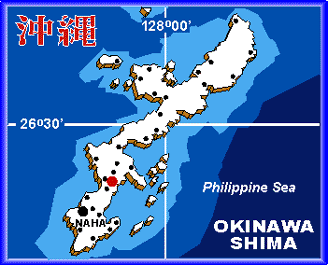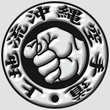• KARATE-DO
OKINAWA KARATE-DO
 |
The scripts about AN ANCIENT FORM OF EMPTY HANDS MARTIAL ART do not exist. Therefore, that part of the historical development remains based on certain spoken legends.
As to the question of KARATE origin, it is considered that the "EMPTY HANDS" art of fighting, once called "TE" and "KEMPO", was transferred from China to Okinawa a long time ago, at the time of Chinese dynasty Tang (618-907). In the encyclopedia "SEKAI-DAI-HYAKKA-JITEN" (published in Tokyo in 1957), the hypothesis about the time when this art of fighting came into existence is supported by relatively strong facts, and it is based on observation of the classical Ryukyuanic dance, which is known to originate from this period. Parts of the dance performed by male dancers are almost identical to some movements in KARATE.
For a certain period of time, the development of Okinawa practicing art of EMPTY HANDS and Martial Arts in general, as well as possession & carrying weapons, were prohibited by an edict of authorities of that time. Nevertheless, this art was practiced secretly, and the period in question was considered to be the most fruitful one in terms of the preservation and the development of this art. It cannot be determined with precision when the secret practicing of EMPTY HANDS martial art ceased. A few contemporary authorities agree that secrecy in practicing was kept almost by the year 1903 due to inertia, though in the seventh year of the era Meiji (1875) the Ryukyu archipelago (and hence also Okinawa as its largest island) officially became a part of the Japanese empire, whereby the former laws and edicts were abolished.
On 25th October 1936 associations of Okinawan "EMPTY HANDS" Martial Arts declared the EMPTY HANDS kanji characters (KU / KARA & TE) as the official for this art, and from that time its official name is KARATE. In 2005, Okinawa Prefecture Assembly officially determined the date of Octobar 25th as "DAY OF KARATE".
A variety of the CHINESE KEMPO styles that had influenced the development of karate over the ages, contributed to the development and multitude of the Okinawan styles (RYUHA) which exist on Okinawa today. In the first part of XX century four Karate streams were defined:
| (1) | SHURI-TE | — in region of Shuri-City, | |
| (2) | NAHA-TE | — in region of Naha-City, | |
| (3) | TOMARI-TE | — in region of Tomari-town, and | |
| (4) | PANGAI-NOON |
After 25 th October 1936, SHURI-TE was called SHORIN-RYU, NAHA-TE was called GOJU-RYU and TOMARI-TE assimilated into SHORIN-RYU and GOJU-RYU. PANGAI-NOON was renamed to UECHI-RYU in 1940. So, today, official Okinawan Karate systems are:
| (1) | SHORIN-RYU | ||
| (2) | GOJU-RYU | ||
| (3) | UECHI-RYU |
All TRADITIONAL OKINAWA KARATE-DO styles existing today can be traced back to the one of the above mentioned Karate systems.
In the first half of the XX century this art was imported to Japan and then very quickly to other parts of the world. It became one of the most popular of Martial Arts of the Far East. Very soon, on the basis of OKINAWAN KARATE, many new styles have been formed in Japan mainland, but they are adapted to sports’ and competitions’ trends.
IN OKINAWA, MARTIAL ART OF KARATE-DO CONTINUED TO DEVELOP IN ITS ORIGINAL, TRADITIONAL FORM.
The RYUKYU archipelago is a boundary between the East Chinese Sea and Pacific Ocean. It is located between 127 & 130 parallels of east geographic length and 25 and 30 parallels of north geographic latitude. It consists of over 130 islands of volcanic origin. Main islands, from north to south, are: Amami, Tokuno and Okinawa. Okinawa is the largest island of Ryukyu archipelago, with the area of 1120 square kilometers (length: 96, 5 km, medial width: 10 km).
RYUKYU archipelago was independent kingdom until XXVI century. Today, it is the southernmost Japanese Prefecture Okinawa. Certain period of independence enabled a predominant influence of China, which created a unique cultural heredity of RYUKYU. When the King of RYUKYU, Satto, established diplomatic relations with China, and declared his loyalty to Chinese’s Emperor Ming (whereby kingdom of Ryukyu became a Chinese dominion in some way), a large economic and cultural exchange between two countries commenced. The Empty Hands Martial Arts was a fragment of that exchange.
During a rule of the king Satto, RYUKYU kingdom was divided into three confronted feuds: northern Chutsan, middle Nantsan and southern Hokutsan, which struggled for dominance in the kingdom. At the beginning of XV century (1429), Sho Hashi (overlord of the Chutsan) was overthrowing his rivals and established reign of his own dynasty. For his capitol he chose Shuri city located in the south of Okinawa. Sho Hashi’s rule enjoys reputation as the most prosperous period for the kingdom. Trading expanded to other countries, such as Indonesia, Malaysia, Thailand, etc.
Because of its highly important strategic position, Okinawa was a ground of many battles. From modern history “Battle for Okinawa" between Japan and USA in the Second World War, which took place from April to June 1945, is well-known. After capitulation of Japan on 9th September 1945, USA annexed the territory of Okinawa and established its largest military air base on the Far East. Okinawa returned under constitutional and judicial system of Japan in 1972.
| • • • |
